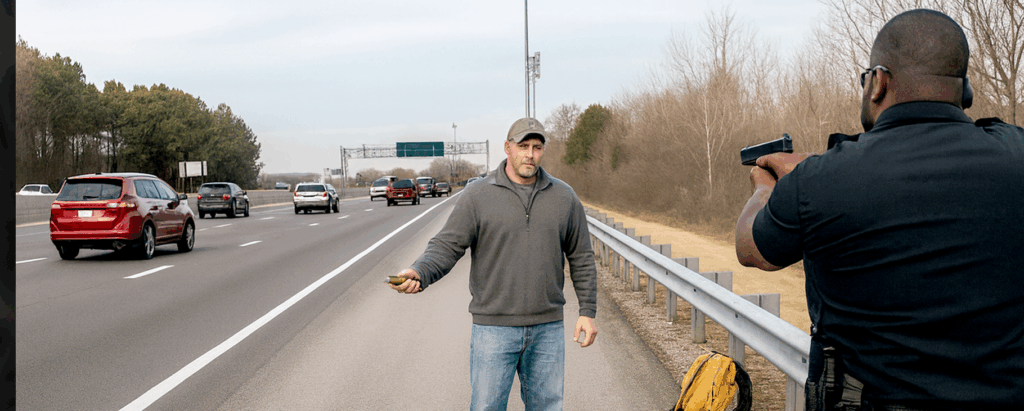Police-vehicle encounters — including traffic stops and pursuits — pose unique dangers for law enforcement officers. When a driver attempts to evade police or uses a vehicle as a weapon, decisions must be made in fractions of a second, often under intense stress. In the Lexipol webinar, “Cops and Cars: Changing the Training Paradigm,” Chief (Ret.) Mike Ranalli, Chief Ken Wallentine and attorney Laura Scarry explore how officers can make safer decisions. The panelists discuss the human factors at play and what the law says about the use of force in these high-stakes scenarios.
The discussion draws from real-world incidents, including the recent Supreme Court case Barnes v. Felix, and combined lessons from neuroscience, case law, and principles of effective training. Here are five key points for law enforcement agencies to focus on to reduce risk and improve outcomes in police-vehicle encounters.
“That small little piece of lead and copper is not going to stop that 3,000-pound vehicle with all that kinetic energy coming toward you.”
1. Split-Second Decisions
When a vehicle suddenly accelerates toward an officer, there’s usually not a lot of time for careful, deliberate analysis. Ranalli draws on Daniel Kahneman’s book, Thinking, Fast and Slow to explain that officers operate in “system one” mode in such moments — fast, intuitive and based on what he called “what you see is all there is.” As he says, “Sometimes you’re going to be thrown into those situations … But if you have discretionary time, tactical breathing, slow things down, use the time to not put yourself into a situation where you have to make that split-second decision.”
Wallentine compares this instinctive reaction to a “German shepherd and rabbit” reflex. In spite of training, the drive to chase or confront can override rational safety considerations. These responses are not a sign of recklessness, Ranalli and Wallentine stress, but rather the result of deeply ingrained patterns shaped by training and repetition. To change them, agencies need to leverage training and policy to deliberately rewire officers’ default responses before the crisis occurs.
Watch a clip:

2. Totality of Circumstances
The panel spends significant time on Barnes v. Felix, the 2025 case in which the Supreme Court reaffirmed that the constitutionality of force must be judged on the totality of the circumstances — including the events leading up to the moment force was used. In Barnes, Scarry explains, Officer Felix stopped a driver suspected of having unpaid tolls, positioning himself behind the vehicle’s open door. When the driver attempted to flee, the officer jumped on the door sill and ultimately shot the driver when he refused to stop. Lower courts had applied a “moment of the threat” test, ignoring the officer’s earlier decision to climb onto the door sill and put himself in danger. The Supreme Court rejected that approach.
Scarry notes, “Lexipol’s use of force policy has always been based on the totality of the circumstances known to the officer.” This means training and policy should prepare officers to anticipate how their pre-threat actions will be scrutinized. As Ranalli puts it, “It’s not enough to just know what the law allows … You’ve got to look at what’s right — what’s safer for the officers and the people they’re dealing with.”
Watch a clip:

3. Emphasize Safety Training
During the discussion, the presenters return again and again to the core idea that officer safety must come first. An officer’s life, after all, is more important than arresting any given offender. Wallentine expresses frustration at seeing officers step into the path of an oncoming car or cling to a moving vehicle when the suspect could likely be identified and apprehended later. And shooting at an oncoming car (instead of jumping out of the way) is almost always a bad idea, he says: “That small little piece of lead and copper is not going to stop that 3,000-pound vehicle with all that kinetic energy coming toward you.”
To counter these unsafe instincts, Ranalli urges leaders to “plant the seeds” of safer responses in officers’ minds and then reinforce them with realistic training. This includes scenario-based drills, stress inoculation and breaking away from static firearms qualifications that reinforce standing in place. “The body won’t go where the mind has never been,” he reminds the audience. That means officers must practice moving perpendicular to a vehicle’s path, using cover and disengaging when safe to do so — so these actions become instinctive.
Watch a clip:

4. Looming Perceptual Distortion
One of the most striking concepts brought up by the panelists was “looming,” a perceptual distortion where an object moving toward a person appears to grow exponentially larger in the visual field, creating an exaggerated sense of speed and proximity. Ranalli describes it as a “visual phenomenon that can really distort your perception” and cause the brain’s threat-response systems to activate prematurely.
Wallentine explains how, from the point of view of an officer, looming can make a car feel like it is about to strike even when it is farther away than perceived. This can explain why officers sometimes react faster or more aggressively than bystanders expect. As Ranalli notes, investigators unfamiliar with looming might view these reactions as unreasonable if they only consider perpendicular viewpoints or camera angles. Awareness of looming — and its potential to heighten perceived threat — should be integrated into training and post-incident reviews.
Watch a clip:

Today’s Tips: public safety best practices: SUBSCRIBE NOW!
5. Prioritize Officer Safety
For all three presenters, the bottom line is clear: Policies, training, and leadership culture must place officer safety ahead of apprehension in vehicle encounters. For “leaders out there … your life is worth more than anything else,” Ranalli tells the audience. “Don’t put yourself in that situation.”
Making preservation of life a priority requires explicit reinforcement from command staff. If officers believe their agency values arrests over survival, they may take unnecessary risks. Instead, supervisors should champion the idea of “live to catch them another day,” modeling decision-making that favors safety. And of course, training should reinforce this concept as well.
Wallentine cautions that statutes limiting shooting at moving vehicles — while valuable — are no substitute for consistent, realistic training. Agencies should create regular opportunities for officers to practice vehicle-encounter decision-making under stress, including recognizing escape zones, moving to safety and managing competing goals in the moment.
Watch a clip:

Building Safer Reflexes
Changing outcomes in these dangerous scenarios means changing the reflexes officers rely on when “system one” thinking takes over. That change will not come from policy memos alone. It requires repeated, realistic practice under conditions that mimic the stress, time compression and sensory distortions of the field.
As Scarry reminds us, Justice Brett Kavanaugh’s concurring opinion in Barnes v. Felix acknowledges that “when a driver abruptly pulls away during a traffic stop, an officer has no particularly good or safe options.” The best agencies can do is ensure those split-second choices are guided by ingrained habits that maximize the chance everyone survives.
- Webinars



